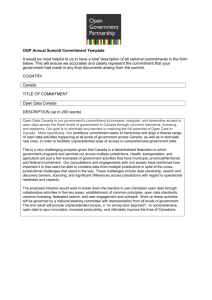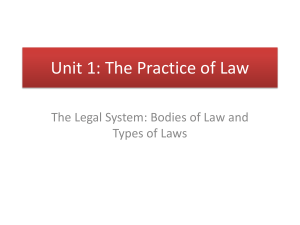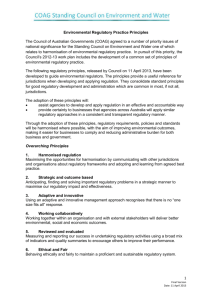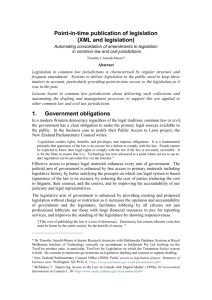Request for information to inform a feasibility study on a
advertisement
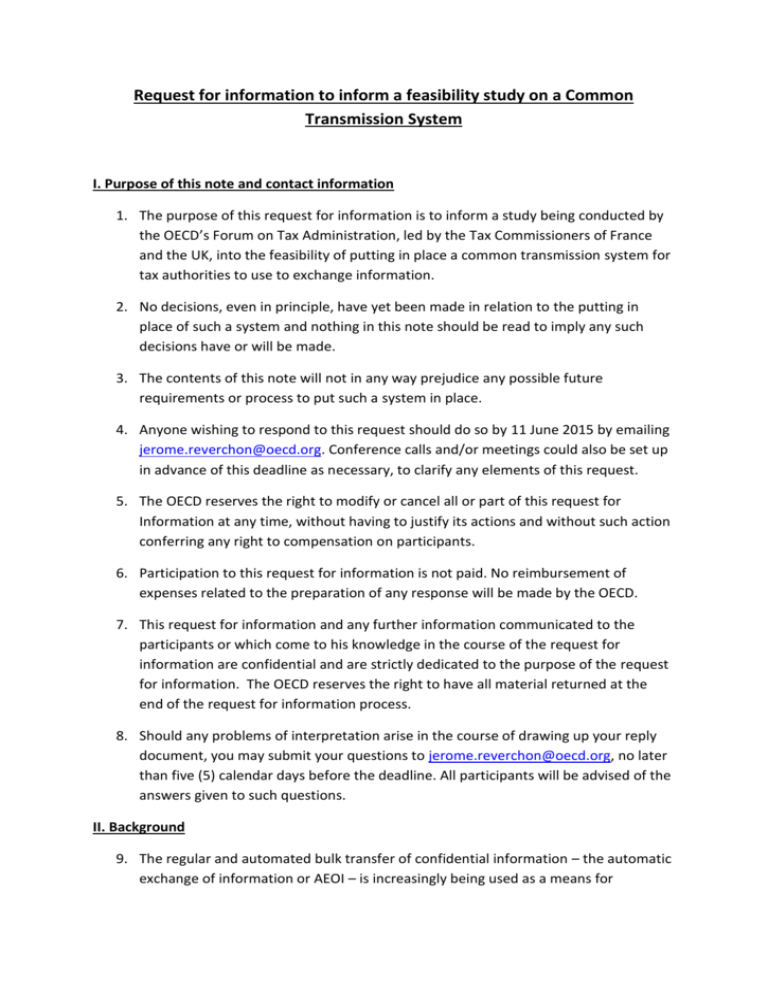
Request for information to inform a feasibility study on a Common Transmission System I. Purpose of this note and contact information 1. The purpose of this request for information is to inform a study being conducted by the OECD’s Forum on Tax Administration, led by the Tax Commissioners of France and the UK, into the feasibility of putting in place a common transmission system for tax authorities to use to exchange information. 2. No decisions, even in principle, have yet been made in relation to the putting in place of such a system and nothing in this note should be read to imply any such decisions have or will be made. 3. The contents of this note will not in any way prejudice any possible future requirements or process to put such a system in place. 4. Anyone wishing to respond to this request should do so by 11 June 2015 by emailing jerome.reverchon@oecd.org. Conference calls and/or meetings could also be set up in advance of this deadline as necessary, to clarify any elements of this request. 5. The OECD reserves the right to modify or cancel all or part of this request for Information at any time, without having to justify its actions and without such action conferring any right to compensation on participants. 6. Participation to this request for information is not paid. No reimbursement of expenses related to the preparation of any response will be made by the OECD. 7. This request for information and any further information communicated to the participants or which come to his knowledge in the course of the request for information are confidential and are strictly dedicated to the purpose of the request for information. The OECD reserves the right to have all material returned at the end of the request for information process. 8. Should any problems of interpretation arise in the course of drawing up your reply document, you may submit your questions to jerome.reverchon@oecd.org, no later than five (5) calendar days before the deadline. All participants will be advised of the answers given to such questions. II. Background 9. The regular and automated bulk transfer of confidential information – the automatic exchange of information or AEOI – is increasingly being used as a means for cooperation between tax authorities to ensure internationally mobile taxpayers comply with their tax obligations. 10. In 2014 the OECD, working with G20 countries, published a new international standard in the automatic exchange of financial account information - the Standard for Automatic Exchange of Financial Account Information in Tax Matters (the “Standard”). 11. The Standard requires the collection by tax authorities of information on assets held by financial institutions for taxpayers (individuals and entities) resident abroad, which is then subsequently exchanged on an annual basis with the relevant tax authorities abroad. 12. The Standard includes a pre-determined XML format that must be used to prepare the information and requirements that the data is kept confidential and encrypted during transmission. 13. By the end of 2014 58 jurisdictions had committed to implement the Standard to a timetable that would see the first annual exchanges of information commence by the end of September 2017. A further 36 jurisdictions will begin exchanging information by the end of September 2018 (see here for a complete list of the jurisdictions). 14. Given the complexity and cost associated with participating jurisdictions establishing bilateral transmission solutions in time to provide for exchanges to the timetables committed to, the OECD is exploring the feasibility of putting in place a common system for transmission between all participating jurisdictions, following a mandate provided by the Tax Commissioners at the last plenary meeting of the Forum on Tax Administration. III. Scope 15. The scope of this study is to assess the feasibility for putting in place a common system for the tax administrations from all committed jurisdictions to exchange highvolume bulk information on an annual basis under the Standard (the “System”). 16. Any solution would therefore need to be up-scalable to accommodate both further jurisdictions joining the exchange of information under the Standard. It must also allow for the automatic exchange of information between tax administrations in relation to other international standards that might be developed. 17. High-frequency-low-volume exchange (the exchange of information on request) should also be contemplated in addition to the low-frequency-high-volume exchanges required under the Standard (as referred to separately in the response template in Annex 1). 18. As shown in Diagram 1, the element of the process that is the subject of the feasibility study is the actual transmission of the information between tax administrations (the “pipe” or System). This therefore does not include data storage or file preparation prior to the sending of the information or any processes following the receipt of the data (e.g. relating to encryption, compression, storage etc.), although associated tools could be provided as ancillary services. Diagram 1: The scope of the project IV. Assumptions and business rules Usage There will be approximately 58 jurisdictions using the System by September 2017 and approximately 100 jurisdictions by September 2018. All jurisdictions will be both senders and receivers of transmissions within the System. Based on the above assumptions, a maximum of 10,000 exchange relationships are to be expected (taking into account two-way transmissions), with around 25-50 transmissions per year and per relationship. Files up to 500MB (compressed) may be provided for. Each jurisdiction will have on average between 5 and 20 individual users of the System. Up to 25% (and possibly even up to 50%) of users may be active on the System at one time. Business rules There shall be a policy for ensuring the legal protection of the data transmitted and subject matter access, including the definition of the moment in time at which the transmission of ownership occurs. There shall be a commonly agreed policy towards the minimum standards for warranting confidentiality, integrity and non-repudiation of data transmissions through the System. The files to be sent through the System shall be subject to minimum common file format and preparation rules. There shall be an agreed upon protocol for the metadata (the message envelope). V. The high-level features of the service High level description 19. The security of the System must be ensured. The System must ensure that all files exchanged are encrypted. There must be no ability for the System or the System operators to open the encrypted files. The transmission pathway itself must also be encrypted. 20. The System should consist of proven technology and the performance of the System should be improved as electronic data exchange technology improves. The System must allow for both push and pull models for data transmission (with the latter requiring the temporary holding of data), as well as notifications to the users. Full configuration and testing will be required. 21. There must be controls over identity and user access to the System, with only authorised users being permitted to use it. Elements of the System must be configurable by users. 22. The user experience and support services provided must include: a. An accessible System that is straightforward to use b. The management of user accounts c. The provision of online documentation d. Telephone and email user support across time zones 23. Supervision and reporting will be required, including the diagnosis and resolution of issues (including in relation to data security) and the reporting of management information on performance. 24. Service Level Agreements that aim for a high level of service performance will need to be established. VI. The features of the service in greater detail Security The System shall ensure that transmission takes place through a secure encrypted pathway and the System shall comply with the pre-defined minimum encryption standards (the public encryption keys used to encrypt the data are not to be provided by the System, which will only encrypt the message metadata). Data transmitted must be kept confidential throughout the transmission process with measures in place to ensure the integrity of the data and for non-repudiation. Data containing personally identifiable sensitive information must be encrypted. The System shall ensure that only encrypted data (the format of which is to be immaterial to System) may be transmitted and that, consequently, no unencrypted data may be transmitted. While it should not be possible, the System shall nevertheless immediately delete or reject any unencrypted file that is uploaded or attempted to be uploaded in error. System The System shall be available internationally. The System shall be available at least 24 hours a day and 6 days a week, with scheduled maintenance phases ideally taking place on Saturdays. The System shall support a number of concurrent users on a contractual basis. The System shall have the capacity of being interoperable with other IT-networks, for example a regional hub. The System shall allow both browser-based and machine-to-machine uploading and downloading of files. The System shall allow transmission of data by uploading by the sender and a download on demand by the recipient (pull model). The System shall only transmit the data, not store the data, except for pre-defined minimal file retention periods required to complete the transmission process in case a recipient opts for the pull model. The System shall have the capability of accommodating the transmission of files of up to a size of 500 MB. The System shall only accept files that have pre-defined metadata characteristics. The System shall provide notifications to the users, including in relation to transmission status and the availability of files for retrieval. The System shall delete any files or parts of a file in the case of a transmission error. In such case, the System shall notify both sender and intended recipient that there has been an error and the deletion. A testing environment to test the System will need to be provided, including for jurisdictions to test the end to end functioning of the System. User access and configuration The System shall verify the identity of users and shall ensure that access is to be limited to authorised users. The System shall support both machine-to-machine based authentication and individual user authentication. Access to the System shall be available to users on a self-service basis (independently from their respective work stations), with tax administrations having the possibility to add further users within their organisation. Authorised users must be able to log in and out of the System at any time, with the exception of maintenance times. Authorised users shall be able to transmit and receive files at any given time and on a self-service basis. The System shall allow user configuration for access to the System. A tax administration using the System shall have the capacity to define an administrating user. The System shall allow for both primary and delegated users within a tax administration to exchange information and will make sure that the responses and other notifications are channeled to the right user. The System shall allow users to specify specific addresses for particular files to be sent to within the tax administration (i.e. depending on the subject matter). The System shall allow receiving jurisdictions to restrict the size of files to be transmitted. The System shall allow users to configure methods for receiving alerts: email and/or via the System. User experience and support services The System shall have a user interface. The System documentation must be published online. The System shall be able to accommodate visually impaired persons. In the first instance, the System shall be operated in English. The System shall, however, have the capacity to be operated in further languages. Information on the encryption standards applied by users of the System and a list of the issuers of encryption keys shall be maintained (centrally) and updated regularly. A support service must be provided both in relation to level one and level two issues, such as user access issues and technical transmission issues. Support must be provided both by email and telephone. As a minimum support should be in English. Support must be available during standard business hours in the local time zone for the users. Supervision and reporting There must be an ongoing diagnosis and resolution of connectivity and transmission issues (including issues in relation to data security). The System shall monitor access through audit logging and define a means to make the audit files available to users. The System shall provide information on the identification of users, time, date, action undertaken. The System shall automatically notify the users of any successful, unsuccessful and retry transmission and shall provide users with information about the number and size of files sent, the transmission time and the result of the transmission. The System shall maintain a record of alerts to users and allow user to retrieve those records for a defined period of time. The System shall sort data transmissions (e.g. by sender, by recipient, by date, by time range, etc.). Upon demand, the System shall be capable of generating statistical data on data transmission and should have the capacity to generate jurisdiction-specific profiles. Service Level Agreements The System shall be managed in accordance with a service level agreement, committing notably to System availability, response times and transmission times. The service level agreement shall further, inter alia, define the scope of the helpdesk service, as well as provisions on the regular maintenance of the System, the maximum offline periods, the management of incidents, including a disaster recovery policy, change management and any further service provider requirements, as deemed adequate. VII. Timeframe 25. Responses to this request for information are required by 11 June 2015. These responses will inform a feasibility study in time to make a potential decision on the way forward by the end of July 2015. 26. A working assumption at this stage is that the System would need to be fully developed by the end of 2016 at the latest, and preferably by the end of September 2016, to allow for user access and testing and in good time before the first transmissions in September 2017. VIII. Business model 27. The current working assumption for this request for information is that the OECD will put in place an agreement with an external supplier/partner to develop and put in place the System and the associated support services. While the users would interact with the System and support services directly, the OECD would provide the interface between the supplier and the jurisdictions in relation to the user agreements themselves, including the collection of fees. Any overall business structure with the supplier should support this business model in a clear and simple way. 28. The above business model is a current working assumption. It is also possible an alternative model could be pursued, as set out in the response template in Annex 1. Either model is subject to further adaptations and modifications. Annex 1: Response template This template is intended to collect high-level information on the capacity of potential providers to either develop a system that would meet the description above or to instead adapt an existing system accordingly. Most importantly, and in order assess the feasibility of this project as a whole, the focus should be on estimating the time it would take to develop such a system and the associated costs. While precision is preferable, estimates could also be presented in ranges or as high-level qualitative descriptions. No response will in any way be seen as binding on the respondent (and caveats and disclaimers may be provided by the respondent), but will instead be used to inform the analysis to determine whether to pursue the development of such a System. Ability to meet the requirements to the timescale set out Requirement Ability of system to meet it Delete as appropriate. 1. Meeting the usage assumptions [Already met] [Met with minor modifications] [New development required] 2. Security requirements [Already met] [Met with minor modifications] [New development required] 3. System features [Already met] [Met with minor modifications] [New development required] 4. User access and configuration [Already met] [Met with minor modifications] [New development required] 5. User experience and support services [Already met] [Met with minor modifications] [New development required] 6. Supervision and reporting [Already met] [Met with minor modifications] [New development required] Notes Include a high level description of any further work that would be necessary to meet the requirement, how long it would take and key risks. Requirement Service levels offered 7. Service Level Agreements Cost estimates Year 1 Year 2 Year 3 Year 4 Year 5 Fixed costs System development costs System maintenance costs Installation costs to connect users Variable costs Support costs (helpdesk etc.) Other variable user costs (e.g. by usage) Please set out below, in high-level terms, the key factors behind each of the cost estimates and the impact they have on the overall estimates. Please set out below the estimated impact on the costs of: 1. Also using the system for low-volume-high-frequency exchanges (the exchange of information on request). Note: this could include large files sizes (e.g. containing many pdf files etc.) 2. The users instead concluding standardised agreements directly with the supplier, including for the charging of fees, rather than via the OECD. 3. Reducing the maximum file size from 500MB. Please set out below the overall timeline you consider reasonable for System inception and the key related milestones. Other information Please set out any ancillary services you would suggest providing to support the successful transmission of data (e.g. training and support in file preparation) and a rough estimate of their costs. Please set out below any other information you think would be useful in relation to completing the feasibility study. For example, whether the system you are describing has been deployed before, along with links to any reference materials.
